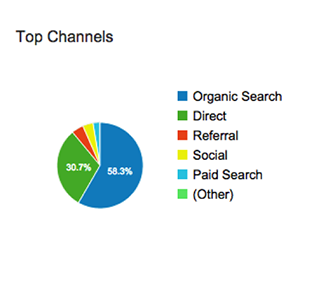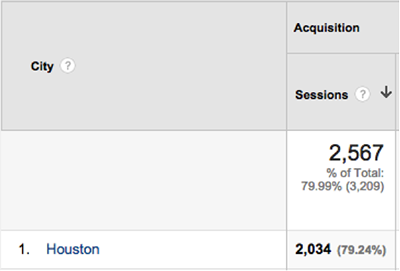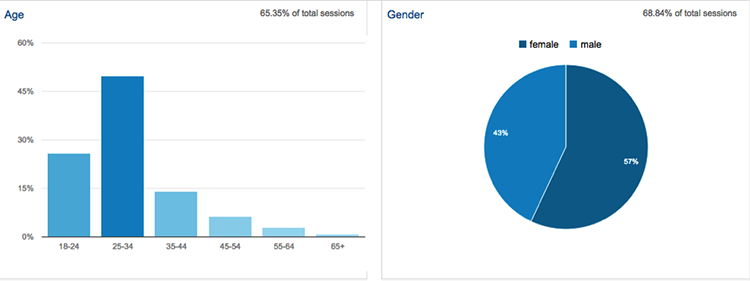three powerful analytics insights to measure the impact of your apartment marketing strategies

Measurement and marketing go hand in hand; as marketers and property managers look to make sure they are getting the most out of their multifamily marketing plan, it becomes critical to find ways to measure these efforts and really ascertain how your marketing efforts are stacking up against your bottom line. While Big Data and analytics have quickly become buzzwords around most businesses, better understanding your visitors can help ensure that you are aligning your marketing movements with your target customer.
While this may seem like the type of measurement that’s reserved for a quarterly review, Google Analytics can actually provide some pretty compelling insights to help you understand whether your efforts are on target, or where certain channels might be missing the mark. Let’s take a look at how to break down some of the information within your Analytics reports to provide actionable insights on your apartment-marketing plan.
acquisition analysis: how are people finding my site?
The first report that we’ll discuss in detail today is the acquisition report in Analytics. Acquisition is going to be a series of intricate looks at the different channels that contributed to driving traffic to your website, and how users behaved after arriving through these channels. Whether you’re getting the bulk of your current traffic through organic search, or simply getting traffic from people following links to your site, it’s important to know what efforts are actually bringing users to the site, and how they’re paying off.
Regardless of where the bulk of your visits are coming from nearly everyone in marketing agrees that over-reliance on one specific channel can be myopic at best, and catastrophic at worst. Kiss Metrics points out that it is important to have a diverse number of sources for incoming traffic, while Moz underscores the importance of diversifying your traffic sources:
“No single source of traffic is wholly “safe,” but a diversified portfolio has much less associated risk…Diversification makes it less likely that a road bump in any single channel can have a devastating impact on your overall business.”
Having consistent visits from a variety of different sources should be the first step in assuring that your marketing efforts are making the right kind of strides. Evaluate traffic, and be sure that organic, social, paid, and direct traffic are all sending visits to your site. Furthermore, be sure that you have referral traffic coming to your site from a variety of different sources. A healthy traffic portfolio should look like this:

To view this report, navigate to Acquisition, and then check the Acquisition Overview. While traffic is still perhaps a little over-reliant on organic search, the brand has established affinity with its users to attract direct visits, and still has a healthy percentage of its traffic coming from sources like social, paid advertising, referrals, and other campaigns.
Go a step further after evaluating your acquisition channels to be sure that the visitors coming in from these channels represent your qualified customer. Two metrics that can help us ascertain this information include conversion and bounce rate.
Bounce rate will immediately give us a sense of how visitors from different channels are receiving your content, and if it’s a good match for their needs. Looking at bounce rate from this sample, we can see that those who found this site through organic search, for example, tended to visit other pages rather than retreat back to the SERP from whence they came–and this can only be good. A low bounce rate signifies that the user is engaged with your content, that it’s a good match for what they’re looking for, and that they’re continuing to explore the site and potentially convert.

Similarly, taking a glance at the conversion rate metrics in the same screen will allow you to see, on the whole, how visitors from certain channels tended to convert. This will allow you to better understand how marketing through certain channels is impacting your lead acquisition and bottom line, and may help you to better segment your marketing budget to ensure that the segments driving the most conversions are going to be the perfect segments for converting traffic.
In this small sample, the apartment SEO work that’s being done on the site is responsible for most of the contacts and leads that have been generated for the property management company:

Pro Tip: Use Advanced Segments to isolate the different acquisition channels within Analytics, and then navigate to different screens, like Conversions > Goals > Overview. By viewing this report with advanced segments enabled, you can look at different acquisition segments and when they resulted in conversions, in addition to unpacking other valuable insights!
location analysis: are my visitors in my target market?
When marketing a multifamily property, it is also increasingly crucial that those who are finding your site and filling out the contact form are the prospective residents that are ready to move into your neck of the woods. Google Analytics also gives us powerful insights into where visitors are coming from, allowing us to understand if our marketing is reaching the visitors who are more likely to move into our units. Drill down to understand what country, what state, and what city these visits are coming from, and where those visits have been acquired.
You may be shocked to find that the town’s local weekly magazine ad is actually driving more visits to your site in your immediate locality than you originally thought. Or, on the other hand, looking location might provide insights that users who are finding the site through one medium or another may be in the wrong location, entirely. This can help you make big decisions about your marketing spend, allowing you to adjust your revenue to allow for maximum ROI based on conversion and location.

This apartment, located in Houston, was probably relieved to see that over 79% of their users are within their target market. This ensures that those who are coming to the site are qualified leads who are looking to live within your area.
developing your personas: what else can analytics tell me?
Understanding more about the people coming to your site will help you and your marketing team make the necessary adjustments to your overall game plan to maximize conversion and ROI. As marketers look to understand more and more about how to gradually improve their conversion rate, Google Analytics is also hard at work trying to supply marketers with more information about their visitors.
In conjunction with the information collected by cookies for Google’s Display Network, Google Analytics also uses data to best estimate the age, gender, and inferred affinity categories and interests of your users. This can help get a clearer picture of the person behind the visit, providing you with insights about how to better refine your message. Consider age range and gender, and then ask yourself how your messaging truly appeals to people in that range. Alternatively, look at the images on your site. Do any people on your site look like your target customer?

These evaluations are increasingly more important as marketers work not just to increase visits, but to increase qualified leads to your site. For more information on how to extract important insights from your Analytics reporting, contact us today!
